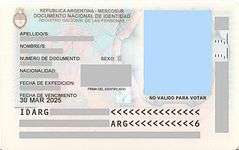Documento Nacional de Identidad (Argentina)


Documento Nacional de Identidad or DNI[1] (which means National Identity Document[2]) is the main identity document for Argentine citizens, as well as temporary or permanent resident aliens. It is issued at a person's birth, and updated at 8 and 14 years of age simultaneously in one format: a card (DNI tarjeta); it's valid if identification is required, and is required for voting. They are produced at a special plant by the Argentine national registry of people (ReNaPer). The front side of the card states the name, sex, nationality, specimen issue, date of birth, date of issue, date of expiry, and transaction number along with the DNI number and portrait and signature of the card's bearer. The back side of the card shows the address of the card's bearer along with their right thumb fingerprint. The front side of the DNI also shows a PDF417 barcode while the back shows machine-readable information. The unique DNI number is semi-perforated through the front-right side of the card. The DNI is a valid travel document for entering Argentina, Bolivia, Brazil, Chile, Colombia, Ecuador, Paraguay, Peru, Uruguay, Venezuela and Guatemala.
Before the introduction of the DNI in 1968, women had a Libreta cívica ("civic booklet"); men a Libreta de enrolamiento ("(military) enrollment booklet").[3][4] For many years, the DNI was issued as a small green booklet (called libreta). In 2009, the DNI was revamped and digitalized; and booklets (now blue) were issued along with an identity card simultaneously. Since 2012, DNIs are issued only in card format. The new DNI card is required to obtain the new biometric Argentine Passport.



References
- ↑ Nuevo DNI, Ministry of the Interior of Argentina, retrieved June 14, 2011
- ↑ New National Identity Document unveiled, Télam, retrieved June 14, 2011
- ↑ Libreta de enrolamiento of Julio Cortázar
- ↑ Argentine government website: How Argentine citizens abroad can apply for a DNI with an existing Libreta cívica or Libreta de enrolamiento (Spanish)